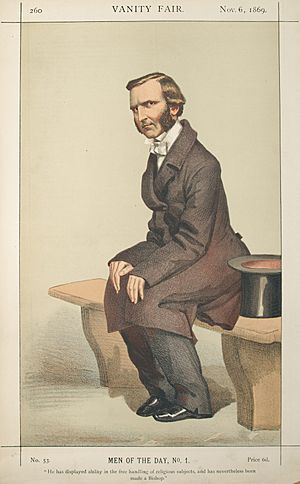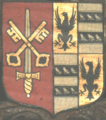Frederick Temple facts for kids
Quick facts for kids The Most Reverend and Right Honourable Frederick Temple D.D. |
|
|---|---|
| Archbishop of Canterbury | |
 |
|
| Church | Church of England |
| Diocese | Canterbury |
| Appointed | 1896 |
| Enthroned | 1896 |
| Reign ended | 23 December 1902 |
| Predecessor | Edward White Benson |
| Successor | Randall Davidson |
| Personal details | |
| Born | 30 November 1821 Santa Maura, Ionian Islands |
| Died | 23 December 1902 (aged 81) London, England |
| Buried | Canterbury Cathedral |
| Nationality | English |
| Denomination | Anglican |
| Parents | Octavius Temple & Dorcas Carveth |
| Spouse | Beatrice Blanche Lascelles |
Frederick Temple (born 30 November 1821 – died 23 December 1902) was an important English teacher and church leader. He held very high positions in the Church of England. He served as the Bishop of Exeter from 1869 to 1885, then as the Bishop of London from 1885 to 1896. Finally, he became the Archbishop of Canterbury in 1896, the most senior leader of the Church of England, a role he held until his death in 1902.
Contents
Early Life and Education
Frederick Temple was born in Santa Maura, one of the Ionian Islands. His father, Major Octavius Temple, later became a governor in Sierra Leone. When his father retired, the family moved to Devon, England. Frederick was first trained for a farming life.
However, Frederick showed great promise in his studies. He attended Blundell's School in Tiverton, Devon. He excelled in academics and sports, especially walking. His family was not rich, so he knew he needed to earn his own way. He won a special scholarship to Balliol College, Oxford, before he was 17.
At Oxford, he earned top grades in 1842. He became a fellow (a senior member) at Balliol College and taught mathematics. Four years later, he became a priest. He wanted to help educate poor children. So, he became the head of Kneller Hall, a college that trained teachers for schools for the very poor. This project did not work out, and he suggested closing it in 1855.
After that, he worked as a school inspector. In 1858, he started teaching at Rugby School. He also became a special chaplain to Queen Victoria in 1856.
Leading Rugby School
Frederick Temple became the headmaster of Rugby School in 1858. He brought a lot of energy and new ideas to the school. He made the school's academic reputation even stronger, especially in classic subjects like Latin and Greek. He also introduced scholarships for natural science and built a laboratory. This showed he believed science was important.
He also changed sports activities at the school. Even though his serious manner could be intimidating, he became popular with the students. He greatly improved the school's reputation. His sermons (speeches) in the school chapel taught the boys about loyalty, faith, and duty.
Around this time, a book called Essays and Reviews caused a big debate. Temple had written the first essay in the book. Some people thought parts of the book were too controversial. Many called for Temple to distance himself from the other authors. His essay talked about how human understanding and spirituality grew over time. Even though his essay was seen as harmless, it was criticized for being in the book. Temple refused to abandon his friends. Later, in 1870, he decided to remove his essay from future editions of the book. He also published his own sermons to show his religious beliefs clearly.
Temple supported William Ewart Gladstone, a famous politician. He also supported the idea of separating the Church of Ireland from the state. He spoke out in favor of the Elementary Education Act 1870, which aimed to improve education for everyone. In 1869, he was offered a high church position in Durham, but he chose to stay at Rugby. However, later that year, he accepted the offer to become the Bishop of Exeter.

As Bishop of Exeter, by "Coïdé" (James Tissot) in Vanity Fair, 1869
Serving as a Bishop
Becoming the Bishop of Exeter caused another controversy. Some church leaders strongly protested his appointment. However, Gladstone stood firm, and Temple was made bishop on 21 December 1869. Some of his clergy found him strict, but his kindness soon became clear. Over 16 years, he won over those who had been against him.
In 1885, when the Bishop of London died, Temple was chosen to take his place. This appointment was widely welcomed. As Bishop of London, he worked incredibly hard, often for 14 or 15 hours a day. He was losing his eyesight, but he kept going. Many clergy members found him demanding, expecting very high standards. But his dedication to his work and his care for people earned him respect.
He was a strong supporter of the Temperance movement, which encouraged people to drink less alcohol. Working-class people saw him as a friend. When his eyesight worsened, he offered to resign, but he was asked to stay. In 1896, after the sudden death of Archbishop Edward White Benson, Temple, at 76 years old, accepted the role of Archbishop of Canterbury.
Archbishop of Canterbury
As Archbishop, Frederick Temple led the important Lambeth Conferences in 1897. These are meetings of bishops from around the world. In the same year, he and the Archbishop of York responded to a letter from the Pope. The Pope's letter questioned the validity of Anglican church services. The Archbishops defended the Anglican Church.
In 1899, the Archbishops again worked together. They were asked to rule on the use of incense and carrying lights during church services. After hearing arguments, they decided against both practices. Temple was very sad about the disagreements within the Church of England. Many of his sermons called for unity among church members.
He was also very keen on foreign missions, encouraging the spread of Christianity around the world. In 1900, he led the World Temperance Congress in London. He also spoke in favor of women's education.
On 9 August 1902, he performed important duties at the coronation of King Edward VII and Queen Alexandra. A few days later, the King gave him the Royal Victorian Chain, a new special award. The strain of his age and duties began to affect his health. On 2 December 1902, while giving a speech in the House of Lords about the Education Bill, he became ill. He managed to finish his speech but never fully recovered. He died on 23 December 1902. He was buried in Canterbury Cathedral. His second son, William Temple, also became Archbishop of Canterbury many years later.
Science and Religion
Frederick Temple was always interested in how science and religion fit together. In 1860, he gave a sermon that welcomed the new ideas of evolution. In his 1884 lectures on "The Relations between Religion and Science," he clearly stated that the idea of evolution does not go against religious teachings. He believed that science and religion could both help us understand the world.
Memorials
Many places remember Frederick Temple:
- The Temple Reading Room and Museum at Rugby School is named after him. It has a bust (a sculpture of his head and shoulders) of him.
- There is a beautiful memorial to him in Canterbury Cathedral. It shows him kneeling in prayer.
- The West Window of Exeter Cathedral also shows him among other important figures from the cathedral's history.
- A bust of Frederick Temple is outside the Big School Room at Sherborne School. He was a governor there for many years.
Honours and Awards
- 1842: Became a Fellow of Balliol College, Oxford.
- 1885: Became an Honorary Fellow of Exeter College, Oxford.
- 1897: Elected a member of the American Antiquarian Society.
- 1902: Awarded the Royal Victorian Chain by King Edward VII.
Images for kids
-
Painting showing Archbishop Temple collapsing in the House of Lords while giving a speech in 1902.



